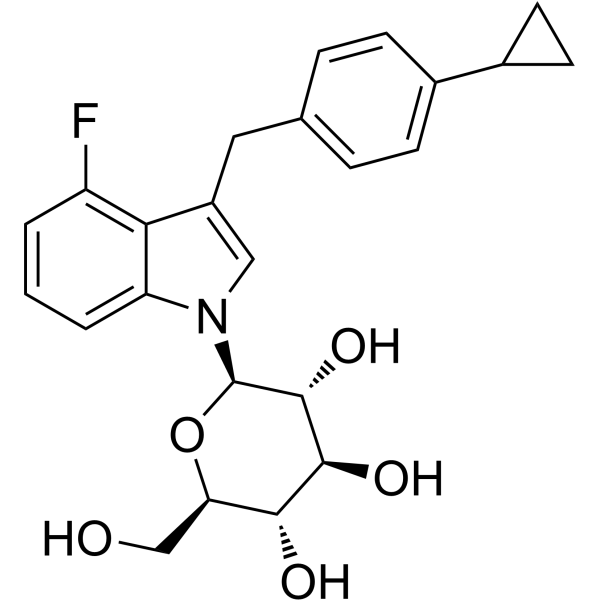1003005-29-5
| Name | (2R,3R,4S,5S,6R)-2-[3-[(4-cyclopropylphenyl)methyl]-4-fluoroindol-1-yl]-6-(hydroxymethyl)oxane-3,4,5-triol |
|---|---|
| Synonyms |
unii-q8bx693uk2
ta-1887 JNJ-39933673 |
| Description | TA-1887 (JNJ-39933673) is a highly potent, selective and orally active SGLT2 inhibitor (IC50: 1.4 nM) with antihyperglycemic effects. TA-1887 can be used in the research of diabetes[1][2]. |
|---|---|
| Related Catalog | |
| Target |
SGLT2:1.4 nM (IC50) SGLT1:230 nM (IC50) |
| In Vivo | TA-1887 (30 mg/kg, oral administration, rats) induces glucose excretion over a 24 h period of 2502 mg per 200 g body weight[1]. TA-1887 (3 mg/kg, oral administration) reduces blood glucose levels without influencing food intake in hyperglycemic high-fat diet-fed KK (HF-KK) mice[1]. TA-1887 (30 mg/kg/day, oral gavage for 2 weeks) significantly reduces GFR (glomerular filtration rate) in BSA-overloaded diabetic mice[2]. TA-1887 (0.01% w/w in chow, HF diets fed mice) antagonizes diabetic cachexia and decreases mortality in diabetic mice[3]. Animal Model: Sprague-Dawley rats[1] Dosage: 30 mg/kg Administration: Oral administration Result: Induced extensive UGE (urinary glucose excretion) through continuous suppression of renal glucose reuptake. Animal Model: BSA-overloaded diabetic mice[2] Dosage: 30 mg/kg Administration: Oral gavage for 2 weeks Result: Suppressed the induction of TGF‐β2 level in vehicle‐treated BSA‐overloaded diabetic mice. Suppressed COL3 gene levels. Animal Model: Male Sprague-Dawley rats (pharmacokinetic assay)[1] Dosage: 3 mg/kg (i.v.), 10 mg/kg (p.o.) Administration: Oral administration (p.o.), intravenous injection (i.v.) Result: Pharmacokinetic (PK) parameters of TA-1887. Parameters dose (mg/kg) Cmax (ng/mL) t1/2 (h) F (%) TA-18873 (i.v.) 3.9 TA-18873 10 (p.o.) 2723 3.9 78 |
| References |
| Molecular Formula | C24H26FNO5 |
|---|---|
| Molecular Weight | 427.46500 |
| Exact Mass | 427.18000 |
| PSA | 95.08000 |
| LogP | 2.22100 |
